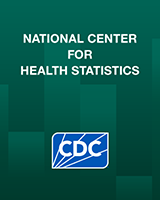
NCBI Bookshelf. A service of the National Library of Medicine, National Institutes of Health.
Prevalence of adults aged 65 and over with complete tooth loss, by demographic characteristics: United States, 2017–March 2020
| Characteristic | Both sexes | Men | Women | |||
|---|---|---|---|---|---|---|
| Sample size | Prevalence percentage (95% confidence interval) | Sample size | Prevalence percentage (95% confidence interval) | Sample size | Prevalence percentage (95% confidence interval) | |
| Total (age adjusted) | 2,075 | 13.8 (10.6–17.6) | 1,058 | 14.0 (10.4–18.3) | 1,017 | 13.6 (10.2–17.7) |
| Total (crude) | 2,075 | 13.2 (9.9–17.2) | 1,058 | 13.4 (9.7–17.8) | 1,017 | 13.1 (9.6–17.4) |
| Age group (years): | ||||||
| 65–69 | 656 | 110.6 (6.6–15.8) | 331 | 12.2 (6.1–21.2) | 325 | 19.1 (5.1–14.7) |
| 70–74 | 530 | 10.8 (7.4–15.1) | 276 | 29.5 (5.7–14.6) | 254 | 11.9 (7.0–18.3) |
| 75 and over | 889 | 17.3 (13.1–22.1) | 451 | 17.4 (12.5–23.3) | 438 | 17.2 (12.4–22.8) |
| Race and Hispanic origin: | ||||||
| Non-Hispanic white | 1,040 | 312.3 (8.0–17.9) | 541 | 312.3 (7.7–18.3) | 499 | 12.3 (7.7–18.3) |
| Non-Hispanic black | 491 | 21.0 (14.9–28.3) | 251 | 422.5 (16.3–29.9) | 240 | 20.2 (12.4–30.1) |
| Non-Hispanic Asian | 157 | *12.7 (5.7–23.2) | 68 | *9.3 (2.3–23.5) | 89 | 15.8 (7.7–27.5) |
| Hispanic | 315 | 18.3 (13.2–24.3) | 150 | 15.8 (8.8–25.2) | 165 | 19.9 (13.7–27.4) |
| Family income relative to federal poverty level (FPL): | ||||||
| 130% or less FPL | 408 | 527.8 (22.8–33.2) | 201 | 525.1 (18.5–32.7) | 207 | 529.2 (23.1–35.9) |
| More than 130% through 350% FPL | 811 | 16.8 (11.3–23.6) | 410 | 19.8 (14.2–26.4) | 401 | 614.7 (9.0–22.1) |
| More than 350% FPL | 551 | *5.8 (2.6–10.9) | 295 | *5.2 (1.7–11.6) | 256 | *6.7 (2.6–13.7) |
| Education: | ||||||
| Less than high school diploma | 470 | 731.5 (26.0–37.4) | 246 | 731.9 (23.2–41.6) | 224 | 731.1 (24.2–38.7) |
| High school diploma or some college | 1,125 | 15.0 (10.8–20.1) | 547 | 17.1 (11.6–23.7) | 578 | 13.5 (9.7–18.2) |
| College degree or above | 471 | 2.7 (1.1–5.4) | 260 | 1.7 (0.5–4.1) | 211 | *3.9 (1.4–8.4) |
Estimate does not meet National Center for Health Statistics standards of reliability.
Significantly increasing trend with increasing age.
Significantly different from those aged 75 and over.
Significantly different from non-Hispanic black adults.
Significantly different from non-Hispanic Asian adults.
Significantly decreasing trend with increasing family income.
Significantly different from men.
Significantly decreasing trend with increasing education.
NOTES: Complete tooth loss in adults is defined here as having no natural tooth, no dental root fragment, and no implanted tooth present and was based on an assessment of 28 teeth, excluding third molars. Except where reported as crude estimates, estimates were age adjusted by the direct method to the projected U.S. Census 2000 population using the age groups 65–69, 70–74, and 75 and over. Statistical comparisons were not performed on crude estimates.
SOURCE: National Center for Health Statistics, National Health and Nutrition Examination Survey, 2017–March 2020 prepandemic data files.

NCBI Bookshelf. A service of the National Library of Medicine, National Institutes of Health.